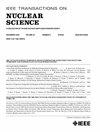Normalization Indicator of Ion-Induced Radiation Damage in Power VDMOS Transistors
IF 1.9
3区 工程技术
Q3 ENGINEERING, ELECTRICAL & ELECTRONIC
引用次数: 0
Abstract
This work presents the impact of heavy ion irradiation on vertical-diffused metal-oxide-semiconductor field-effect transistors (VDMOSFETs), particularly focusing on the ionization and displacement damage pivotal for the operation of devices in space environments. We conducted experiments using irradiation with chlorine, silicon, fluorine, and oxygen ions. Our analysis involves calculating the linear energy transfer (LET) and nonionizing energy loss (NIEL) for various ion incidences, followed by determining the ionizing absorbed dose (功率 VDMOS 晶体管中离子诱导辐射损伤的归一化指标
这项研究介绍了重离子辐照对垂直扩散金属氧化物半导体场效应晶体管(VDMOSFET)的影响,尤其侧重于对器件在太空环境中运行至关重要的电离和位移损伤。我们使用氯、硅、氟和氧离子进行了辐照实验。我们的分析包括计算各种离子发生率的线性能量转移(LET)和非电离能量损失(NIEL),然后根据这些参数确定电离吸收剂量($D _{\mathrm {i}}$)和位移吸收剂量($D _{\mathrm {d}}$)。随后,我们通过检测电离损伤的阈值电压偏移($\Delta V _{\mathrm {TH}}$)、位移损伤的漏极泄漏电流变化($\Delta I _{\mathrm {DLC}}$)和漏极饱和电流变化($\Delta I _{\mathrm {DSC}}$),对重离子辐照的影响进行了归一化处理。我们的研究结果表明,以 $\Delta I _{\mathrm {DLC}}$ 指标为特征的位移损伤是对不同离子种类的影响进行归一化的可靠指标。这一发现对于等效研究功率 VDMOS 晶体管中不同种类的空间带电离子辐照具有重要意义。
本文章由计算机程序翻译,如有差异,请以英文原文为准。
求助全文
约1分钟内获得全文
求助全文
来源期刊

IEEE Transactions on Nuclear Science
工程技术-工程:电子与电气
CiteScore
3.70
自引率
27.80%
发文量
314
审稿时长
6.2 months
期刊介绍:
The IEEE Transactions on Nuclear Science is a publication of the IEEE Nuclear and Plasma Sciences Society. It is viewed as the primary source of technical information in many of the areas it covers. As judged by JCR impact factor, TNS consistently ranks in the top five journals in the category of Nuclear Science & Technology. It has one of the higher immediacy indices, indicating that the information it publishes is viewed as timely, and has a relatively long citation half-life, indicating that the published information also is viewed as valuable for a number of years.
The IEEE Transactions on Nuclear Science is published bimonthly. Its scope includes all aspects of the theory and application of nuclear science and engineering. It focuses on instrumentation for the detection and measurement of ionizing radiation; particle accelerators and their controls; nuclear medicine and its application; effects of radiation on materials, components, and systems; reactor instrumentation and controls; and measurement of radiation in space.
 求助内容:
求助内容: 应助结果提醒方式:
应助结果提醒方式:


